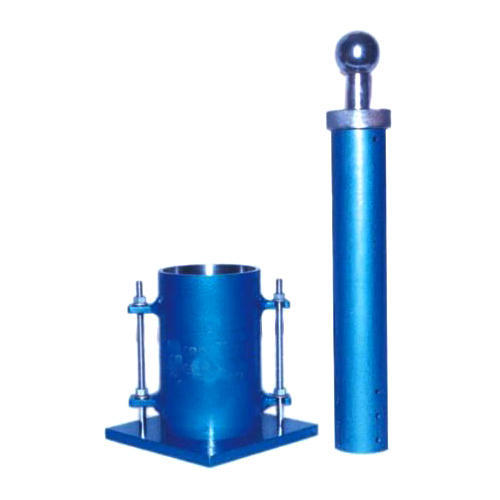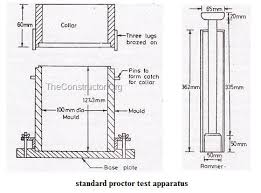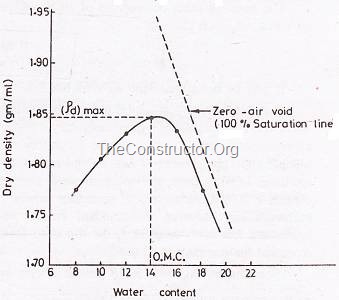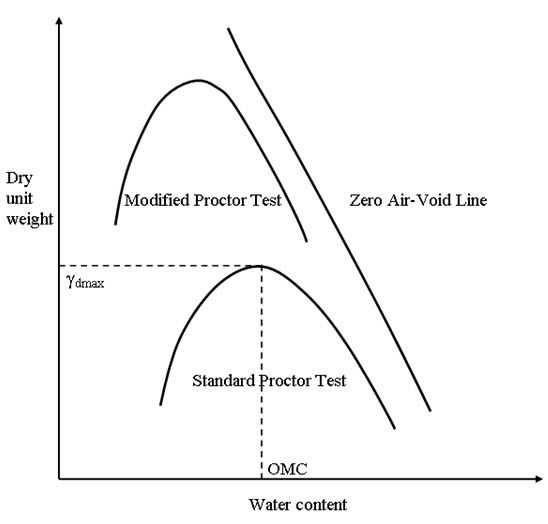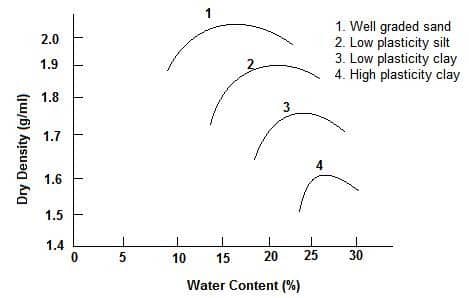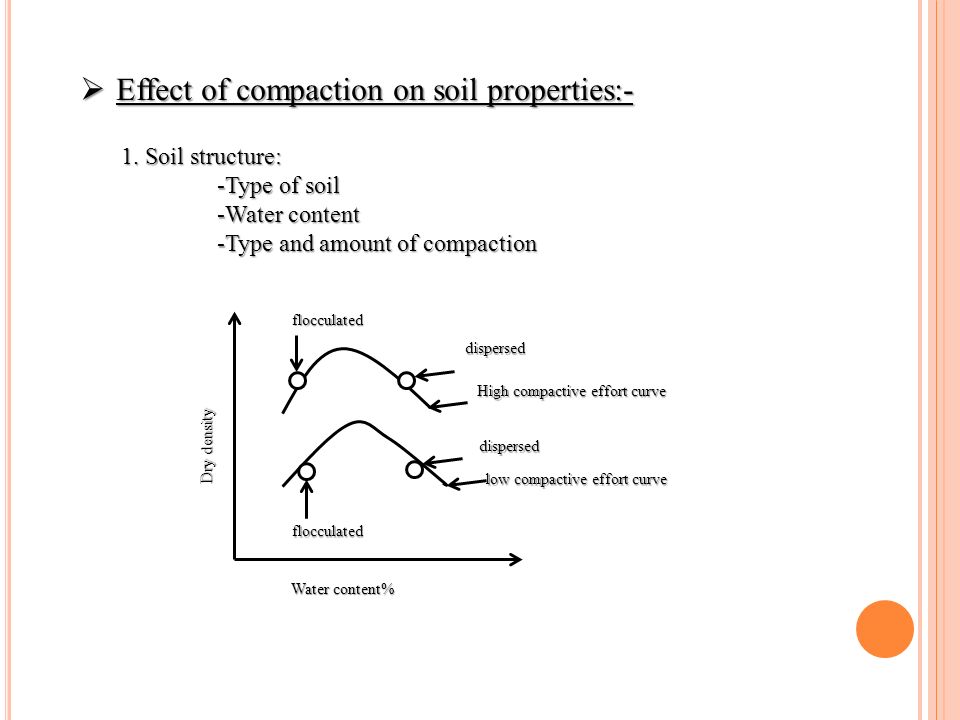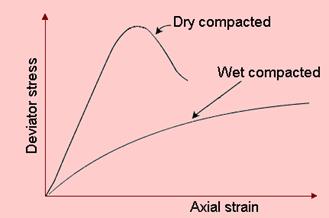Chapter:
1.
Compaction is any process by which the soil particles are artificially rearranged and packed together into a closer state ofcontact by any mechanical means so that the dry density of the soil is increased. Compaction is an entirely different process than consolidation. The following are the main differences between them:
- Consolidation is a gradual process of reduction of volume under sustained, static loading where as compaction is a rapid process of reduction of volume by mechanical means such as rolling, tamping and vibration.
- Consolidation causes a reduction in volume of a saturated soil due to squeezing out of water from the soil where as in compaction, the volume of a partially saturated soil decreases because of expulsion of air from the voids at the unaltered water content.
- Consolidation is a process which occurs in nature when the saturated soil deposits are subjected to Static loads caused by the weight of the buildings and other structures. However, compaction is an artificial process which is done to increase the density of the soil to improve its properties before it is put to any use.
Purposes:
- To increase shear strength and thus increase bearing capacity.
- To reduce compressibility.
- To reduce permeability.
- To reduce potential of swelling and shrinkage.
2. Explain various laboratory compaction test of soil.
A laboratory tests can be used to determine the OMC for a soil under given compaction. The two commonly laboratory compaction test are:
- Standard proctor test (AASHTO Test)
- Modified proctor test (modified AASHTO test)
Standard Proctor Test:
This test was developed by RR Proctor to provide a relationship between the water content and the dry density of soil.
Proctor used a standard model of 4 inches internal diameter and and effective height of 4.6 inches, with a capacity of `1/30` cubic foot. The mould had a detachable base plate, and a removable collar of 2 inches height at it's top. The soil was compacted in the mould in 3 equal layers, each layer was given 25 blows of 5.5 pounds rammer falling through a height of 12 inches. A curve was obtained between the dry density and the water content.
procedures:
About 3 kg of air-dried pulverised soil passing through 4.75 mm sieve is taken. Water is added to the soil to bring its water content to about 4% if the soil is coarse grained and to about 8% if the soil is fine grained. The water content should be much less than the expected optimum water content. The soil is mixed throughly and cover ed without cloth and left for measuring for about 15 to 30 minutes.
The mould is any cleaned, dried and greased lightly. The mass of the empty mould with the base plate but without collar, is taken. The cooler is then fitted to the mould. The mould is placed on a solid base and filled with fully matured soils to about one third of its height. The soil is compacted by 25 blows of the rammer, with a free fall of 310 mm. The blows are evenly distributed over the surface. The soil surface is scratched with spatula before the second layer is placed and compacted. The mould is filled to about two third height with the soil and compacted again by 25 blows. Likewise, the third layer is placed and compacted. The third layer should project above the top of the mould into the Collar by not more than 6 mm.
The collar is rotated to break the bond between the soil in the mould and that in Collar. The Collar is then removed, and the soil is trimmed off flush with the top of the mould. The mass of the mould ,base plate, and the compacted soil is taken, and thus the mass of the compacted soil is determined. The bulk density of the soil is computed from the mass of the compacted soil and the volume of the mould.
Representative soil samples are taken from the bottom, middle and top of the mould for determining the water content. The dry density is computed from the bulk density and the water content.
Bulk mass density,`rho=M/V`
Where,M=mass of compacted soil
V=Volume of the mould
Thus, dry density is:
`gamma_d=rho/(1+w )`
Where, `w=`water content.
The soil removed from the mould is broken with hand. More water is added to the soil so as to increase the water content by 2 to 3%. It is throughly mixed and allowed to mature. The test is repeated and the dry density and the water content are determined.
A graph is plotted between dry density and water content to obtain the compaction curve as shown in the figure. It is observed that the dry density initially increases with increase in water content till the maximum density is attained. With further increase in water content, the dry density decreases. The water content corresponding to the maximum dry density is known as optimum water content OEC or the optimum moisture content OMC.
At water content lower than the optimum, the soil is rather stiff and has a lot of void spaces and, therefore, the dry density is low. As the water content is increased l, the soil particles get lubricated and slip over each other and move into densely packed position and the dry density is increased. However, at water content more than the optimum, the additional water reduces the dry density.
For a given water content, theoretical maximum density is obtained corresponding to the condition when there are no air voids (i.e, degree of saturation is equal to hundred percent). The theoretical maximum dry density is known as saturated dry density. In this condition, the soil will become saturated by reduction in air voids to zero with no change in water content.
3. Explain various compaction lab test of solids.
A laboratory tests can be used to determine the OMC for a soil under given compaction. The two commonly laboratory compaction test are:
- Standard proctor test (AASHTO Test)
- Modified proctor test (modified AASHTO test)
Standard Proctor Test:
This test was developed by RR Proctor to provide a relationship between the water content and the dry density of soil.
procedures:
About 3 kg of air-dried pulverised soil passing through 4.75 mm sieve is taken. Water is added to the soil to bring its water content to about 4% if the soil is coarse grained and to about 8% if the soil is fine grained. The water content should be much less than the expected optimum water content. The soil is mixed throughly and covered without cloth and left for measuring for about 15 to 30 minutes.
The mould is then cleaned, dried and greased lightly. The mass of the empty mould with the base plate but without collar, is taken. The collar is then fitted to the mould. The mould is placed on a solid base and filled with fully matured soils to about one third of its height. The soil is compacted by 25 blows of the rammer, with a free fall of 310 mm. The blows are evenly distributed over the surface. The soil surface is scratched with spatula before the second layer is placed and compacted. The mould is filled to about two third height with the soil and compacted again by 25 blows. Likewise, the third layer is placed and compacted. The third layer should project above the top of the mould into the Collar by not more than 6 mm.
The collar is rotated to break the bond between the soil in the mould and that in Collar. The Collar is then removed and the mass of the mould ,base plate, and the compacted soil is taken, and thus the mass of the compacted soil is determined. The bulk density of the soil is computed from the mass of the compacted soil and the volume of the mould.
Representative soil samples are taken from the bottom, middle and top of the mould for determining the water content. The dry density is computed from the bulk density and the water content.
Bulk mass density,`rho=M/V`
Where,M=mass of compacted soil
V=Volume of the mould
Thus, dry density is:
`gamma_d=rho/(1+w )`
Where, `w=`water content.
The soil removed from the mould is broken with hand. More water is added to the soil so as to increase the water content by 2 to 3%. It is throughly mixed and allowed to mature. The test is repeated and the dry density and the water content are determined.
A graph is plotted between dry density and water content to obtain the compaction curve as shown in the figure. It is observed that the dry density initially increases with increase in water content till the maximum density is attained. With further increase in water content, the dry density decreases. The water content corresponding to the maximum dry density is known as optimum water content OEC or the optimum moisture content OMC.
At water content lower than the optimum, the soil is rather stiff and has a lot of void spaces and, therefore, the dry density is low. As the water content is increased, the soil particles get lubricated and slip over each other and move into densely packed position and the dry density is increased. However, at water content more than the optimum, the additional water reduces the dry density.
For a given water content, theoretical maximum density is obtained corresponding to the condition when there are no air voids (i.e, degree of saturation is equal to hundred percent). The theoretical maximum dry density is known as saturated dry density. In this condition, the soil will become saturated by reduction in air voids to zero with no change in water content.
4. Explain modified proctor test
The modified proctor test was developed to give a higher standard of compaction. This test was standardized by the American Association of state highway officials and is known as the modified AASHO test.
In this test, the mould used is the same as in the standard proctor test. However, the rammer used is much heavier and has a greater drop than that in the standard proctor test. Its mass is about 4.89 kg and the free drop is 450 mm. The face diameter is 50 mm as in the standard proctor test. The soil is compacted in 5 equal layers ,each layer is given 25 blows. The compactive effort in the modified proctor test is about 4.56 time than that in the standard proctor test. Thus, a much heavuer compaction is attained.
If the percentage of soil on a 4.75 mm sieve is more than 20%, the larger mould of 150 mm internal diameter, effective height of 127.3 mm and capacity 2250 ml is used. In this case, 56 blows are required for each layer. The rest of the procedure is similar to that in the standard proctor test.
The dry density is obtained for different water content and the compaction curve is drawn. Figure shows the compaction curve for the modified proctor test. The heavier Compaction increases the maximum dry density but decreases the optimum water content. The percentage increase of the dry density is between 3 % to 18% for most soils; the percentage increase is more for clayey soils than for the sandy soils.
Figure shows the zero air-void line. It may be noted that the maximum dry density attened even in the modified proctor test is lower than the theoretical maximum dry density indicated by the zero air-void lines. The line of optimum shown in the figure joins the points indicating the maximum dry density. It is roughly parallel to the zero air void line.
5. Explain several factors affecting compaction.
Some of the factors which affect compaction are as follows:
- Water Content
- Amount of compaction
- Type of soil
- Method of compaction
- Admixtures
Water content:
At low water content, the soil is stiff and offers more resistance to compaction. The dry density of the soil increases with an increase in the water content till the optimum water content is reached. At that stage, the air voids attains approximately a constant volume. With further increase in water content, the air voids do not decrease but the total voids (air plus water ) increase and the dry density decreases. Thus, the higher dry density is achieved up to the optimum water content due to forcing air out if the soil voids.
Amount of compaction:
The amount of compaction greatly affect the maximum dry density and optimum water content of a given soil. The effect of increasing the compaction result in an increase in the maximum dry density and decreases in the optimum water content as shown in figure.
Type of soils:
The maximum dry density depend upon the type of the soil. Coarse grained soil can be compacted to higher dry density than fine grained soils. With the addition of even a small quantity of fines to a coarse grained soil, the soil attains a much higher dry density for the same compactive effort . However, if the quantity of fines is increased to a value more than that required to fill the voids of the course grained soils, the maximum dry density decreases. A well graded sand attains a much higher dry density than a poorly graded soil.
Method of compaction:
The density of obtained during compaction, for a given soil, greatly depends upon the type of compaction or the manner in which the compactive effort is applied. The various variables in this respect are:
- weight of the compacting equipment,
- the manner of operation such as dynamic or impact, static, kneading or rolling and ,
- the time and area of contact between the compacting element and the soil.
Admixtures:
The compaction characteristic of the soil can be improved by adding other materials, known as admixtures. The most commonly used admixtures are lime, cement and bitumen. The dry density achieved depends upon the type and amount of admixtures.
6. Explain various factors affecting compaction.
Some of the factors which affect compaction are as follows:
- Water Content
- Amount of compaction
- Type of soil
- Method of compaction
- Admixtures
Water content:
At low water content, the soil is stiff and offers more resistance to compaction. The dry density of the soil increases with an increase in the water content till the optimum water content is reached. At that stage, the air voids attains approximately a constant volume. With further increase in water content, the air voids do not decrease but the total voids (air plus water ) increase and the dry density decreases. Thus, the higher dry density is achieved up to the optimum water content due to forcing air out if the soil voids.
Amount of compaction:
The amount of compaction greatly affect the maximum dry density and optimum water content of a given soil. The effect of increasing the compaction result in an increase in the maximum dry density and decreases in the optimum water content as shown in figure.
Type of soils:
The maximum dry density depend upon the type of the soil. Coarse grained soil can be compacted to higher dry density than fine grained soils. With the addition of even a small quantity of fines to a coarse grained soil, the soil attains a much higher dry density for the same compactive effort . However, if the quantity of fines is increased to a value more than that required to fill the voids of the course grained soils, the maximum dry density decreases. A well graded sand attains a much higher dry density than a poorly graded soil.
Method of compaction:
The density of obtained during compaction, for a given soil, greatly depends upon the type of compaction or the manner in which the compactive effort is applied. The various variables in this respect are:
- weight of the compacting equipment,
- the manner of operation such as dynamic or impact, static, kneading or rolling and ,
- the time and area of contact between the compacting element and the soil.
Admixtures:
The compaction characteristic of the soil can be improved by adding other materials, known as admixtures. The most commonly used admixtures are lime, cement and bitumen. The dry density achieved depends upon the type and amount of admixtures.
7. Explain effect of compaction on properties of soil.
The the effect of compaction on various soil properties can be discussed below:
- Soil structures
- Permeability
- Swelling
- Pore water pressure
- Shrinkage
- Compressibility
- Stress-strain relationship
- Shear strength
Soil structures:
The water content at which the soil is compacted plays an important role in the engineering properties of the soil. Soil compacted at a water content less than the optimum water content generally have a flocculated structure regardless of the method of compaction. Soils compacted at a water content more than the optimum water content usually have a dispersion structure if the compaction induces large strain and the flocculated structure if the shear strains are relatively small.
In figure at point A on the dry side of the optimum, the water content is so low that the attractive forces are more predominant than the repulsive forces. This result in flocculated structure. As the water content is increased beyond the optimum, the repulsive forces increases and the particles get oriented into the dispersed structure. If the compactive effort is increased, there is a corresponding increase in the orientation of the particles and higher dry densities are obtained.
Permeability:
The permeability of a soil depends upon the size of voids. The permeability of soil decreases with increase in water content on the dry side of the the optimum water content. The minimum permeability occurs at or slightly above the optimum water content. After that stage, the permeability slightly increases, but it always remains much less than that on the dry side of the optimum. If the compactive effort is increased, the permeability of the soil decreases due to increased dry density and better orientation of particles.
Swelling:
A soil sample compacted dry of optimum water content has high water deficiency and more random orientation and hence exert greater swelling pressure and swell to higher water content than the sample of the same density of obtained from wet side compaction.
Pore water pressure:
A soil sample compacted dry of the optimum has low water content. Thus, the pore water pressure developed for the soil compacted dry of the optimum is therefore less than that of the sample compacted wet of the optimum.
Shrinkage:
For the same density, soil sample compacted dry of optimum shrink appreciable less than the sample compacted wet of optimum. This is so because the soil particles having dispersed structure have nearly parallel orientation and can pack more efficiently.
Compressibility:
Saturated sample of clay, compacted wet side of optimum is more compressible than another sample of the same soil, having the same void ratio, but compacted dry of the optimum, when the applied pressure is in low pressure range. This is so because the sample compacted dry of optimum has flocculated structure and requires extra pressure to cause parallel orientation of particles. However, in the high pressure range, a sample compactor dry of optimum is more compressible than the one compacted wet of the optimum.
Stress-Strain relationship:
For a given soil, a sample compacted dry side of the optimum has a steeper stress-strain curve and hence, has a higher modulus of elasticity than the one which is compacted wet of optimum ,at the same density. Soil compacted dry of optimum have brittle failure while soil compacted wet of optimum, having dispersed structure, continue to increase in strength even at higher strains.
Shear strength:
The strength of compacted clay depends upon:
- dry density
- moulding water content
- soil structure
- method of compaction
- strain used to define strength
- drainage condition and
- the type of soil
In general, at low strains, strength of cohesive soil compacted dry of optimum is higher than those compacted wet of optimum. Figure below shows the failure envelope of two samples of the same soil, one compacted dry of optimum and other compacted wet of the optimum but both compacted at the same density. However, of higher strains, the flocculated structure of the same compacted on the dry side is broken giving rise to ultimate strength for both the samples. The manner of compaction also influences the strength of soil sample compacted wet of the optimum. It is interesting to note that the clay cores in earth dams are usually compacted wet of optimum to tolerate largest settlements without cracking.
8. Explain effect of compaction on various properties of soils.
The the effect of compaction on various soil properties can be discussed below:
- Soil structures
- Permeability
- Swelling
- Pore water pressure
- Shrinkage
- Compressibility
- Stress-strain relationship
- Shear strength
Soil structures:
The water content at which the soil is compacted plays an important role in the engineering properties of the soil. Soil compacted at a water content less than the optimum water content generally have a flocculated structure regardless of the method of compaction. Soils compacted at a water content more than the optimum water content usually have a dispersion structure if the compaction induces large strain and the flocculated structure if the shear strains are relatively small.
In figure at point A on the dry side of the optimum, the water content is so low that the attractive forces are more predominant than the repulsive forces. This result in flocculated structure. As the water content is increased beyond the optimum, the repulsive forces increases and the particles get oriented into the dispersed structure. If the compactive effort is increased, there is a corresponding increase in the orientation of the particles and higher dry densities are obtained.
Permeability:
The permeability of a soil depends upon the size of voids. The permeability of soil decreases with increase in water content on the dry side of the the optimum water content. The minimum permeability occurs at or slightly above the optimum water content. After that stage, the permeability slightly increases, but it always remains much less than that on the dry side of the optimum. If the compactive effort is increased, the permeability of the soil decreases due to increased dry density and better orientation of particles.
Swelling:
A soil sample compacted dry of optimum water content has high water deficiency and more random orientation and hence exert greater swelling pressure and swell to higher water content than the sample of the same density of obtained from wet side compaction.
Pore water pressure:
A soil sample compacted dry of the optimum has low water content. Thus, the pore water pressure developed for the soil compacted dry of the optimum is therefore less than that of the sample compacted wet of the optimum.
Shrinkage:
For the same density, soil sample compacted dry of optimum shrink appreciable less than the sample compacted wet of optimum. This is so because the soil particles having dispersed structure have nearly parallel orientation and can pack more efficiently.
Compressibility:
Saturated sample of clay, compacted wet side of optimum is more compressible than another sample of the same soil, having the same void ratio, but compacted dry of the optimum, when the applied pressure is in low pressure range. This is so because the sample compacted dry of optimum has flocculated structure and requires extra pressure to cause parallel orientation of particles. However, in the high pressure range, a sample compactor dry of optimum is more compressible than the one compacted wet of the optimum.
Stress-Strain relationship:
For a given soil, a sample compacted dry side of the optimum has a steeper stress-strain curve and hence, has a higher modulus of elasticity than the one which is compacted wet of optimum ,at the same density. Soil compacted dry of optimum have brittle failure while soil compacted wet of optimum, having dispersed structure, continue to increase in strength even at higher strains.
Shear strength:
The strength of compacted clay depends upon:
- dry density
- moulding water content
- soil structure
- method of compaction
- strain used to define strength
- drainage condition and
- the type of soil
In general, at low strains, strength of cohesive soil compacted dry of optimum is higher than those compacted wet of optimum. Figure below shows the failure envelope of two samples of the same soil, one compacted dry of optimum and other compacted wet of the optimum but both compacted at the same density. However, of higher strains, the flocculated structure of the same compacted on the dry side is broken giving rise to ultimate strength for both the samples. The manner of compaction also influences the strength of soil sample compacted wet of the optimum. It is interesting to note that the clay cores in earth dams are usually compacted wet of optimum to tolerate largest settlements without cracking.
 Guest
Guest
